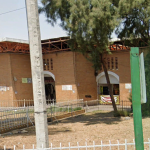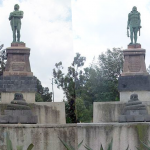Sometimes a Metro station will come to stand for an entire region. Such is the case with Metro Indios Verdes. The busiest station in the network, about 120,000 passengers pass through on normal working days.
 The name comes from the 100+ year old moniker used to refer to the two bronze statues in the Parque del Mestizaje. For most Mexico City residents it is just as common to refer to an enormous part of the northern metropolitan area as “Indios Verdes,” too.
The name comes from the 100+ year old moniker used to refer to the two bronze statues in the Parque del Mestizaje. For most Mexico City residents it is just as common to refer to an enormous part of the northern metropolitan area as “Indios Verdes,” too.
Through the networks of buses, combis, and mini-buses, transport services extend to all kinds of place in the State of Mexico:
But service also reaches as far as the state Hidalgo:
Metro Indios Verdes is thus surrounded by the infrastructure necessary to getting people on and off all of those buses. Alas, one of the solutions, in the form of Metrobus, and its Mexico State counterpart, Mexibus, adds still more infrastructure to the area.
Getting in and out can take some patience the first few times. And most people walking to La Villa will prefer to use Metro Deportivo 18 de Marzo or indeed, Metro La Villa-Basílica. However you choose to go, there’s still a lot to see, including the famous, FARO Indios Verdes cultural center, and the old Aqueduct of Guadalupe. Everything else, and there’s a lot, is collected in a Guide to the Indios Verdes Area.

Nearest at 0.13 kms.

Nearest at 0.16 kms.

Nearest at 0.27 kms.

One of Mexico City's highest elevation neighborhoods...

New life arrives in one of original villages of la GAM, far in the north of Mexico City.

The transfer station for passengers en route to the final two destinations on Cablebús Line 1.

CablebúsLine One can leave you at the base of the famous Cerro del Chiquihuite...

The Ticomán Cablebús station is just the first stop on your way up to the very north of Mexico City.